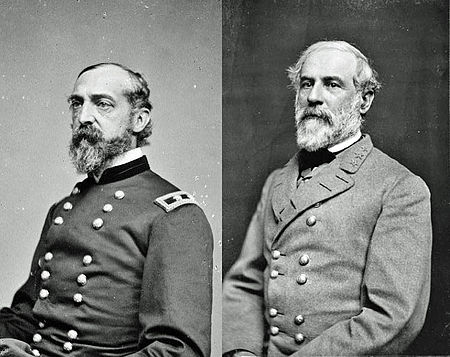
Left: US Gen. George Meade; Right: CS Gen. Robert E. Lee
Today we mark the 150th Anniversary of the third and final day of the Battle of Gettysburg, Pennsylvania, fought between the 75,000-man Confederate Army of Northern Virginia under the command of General Robert E. Lee and the 90,000-man Union Army of the Potomac under the command of Major General George G. Meade.
The action at Gettysburg on Day 3, 3 July 1863. Attribution: Map by Hal Jespersen, www.posix.com/CW
On 3 July 1863, Robert E. Lee launched the famous attack on the center of the Union lines perched on Cemetery Ridge: Pickett's Charge. The charge was so-named because the lead division of the attack was that of CS General George Pickett of Longstreet's First Corps, Army of Northern Virginia. Still, two other divisions also participated, that of CS Generals Trimble and Pettigrew, as well. All told, about 12,000 men would participate in the attack -- and attack that was to target the Union line at the "Copse of Trees" on Cemetery Ridge.

Map of Pickett's Charge. 3 July 1863. Attribution: Map by Hal Jespersen, www.posix.com/CW
These divisions attacked the II Corps of US General Hancock at about 3PM, after an artillery bombardment that was supposed to soften the Union lines. At "the Angle" on Cemetery Ridge, some Confederate troops actually managed to jump the stone wall that anchored the Union line here. This was the "High Water Mark of the Confederacy."
Pickett's Charge by Forbes. The Confederate lines are in the foreground, the Union in the distance.
With the failure of Pickett's Charge, the Battle of Gettysburg was over -- and Lee began the process of retreat back to Virginia the next day.
In the end, the three days had seen the Confederate Army of Northern Virginia bend and batter the Union Army of the Potomac, but not break it. The loss was terrible: some 23,000 Union casualties and 28,000 Confederate casualties. These were men the South simply could not afford to lose.
The retreat from Gettysburg. Attribution: Map by Hal Jespersen, www.posix.com/CW
US General Meade's pursuit of the withdrawing Confederate army would be a point of annoyance for President Abraham Lincoln. Still, Meade at avoided defeat, and that saved his job. There would not be another significant battle in the Virginia theatre for the remainder of 1863. There would be some maneuver, and some bloodshed, in both the Bristow and Mine Run campaigns. More on those, however, in the Fall.
Tomorrow, we head west, where there was significant news on the Mississippi in 1863. Coupled with these events in Pennsylvania, they spell disaster for the South and the Confederate cause.
For more on the Battle of Gettysburg, you might note:
National Park Service Description
Official Website of Gettysburg National Military Park
Civil War Home: Gettysburg
Live well.
No comments:
Post a Comment